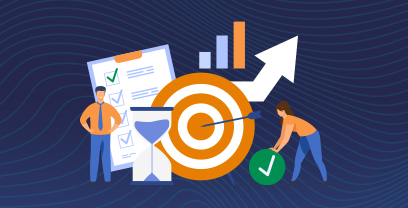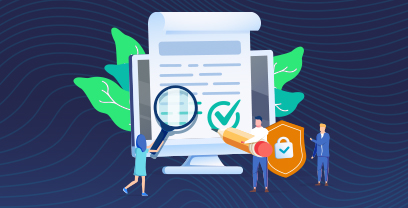Procurement is no longer just about processing orders. Today’s procurement teams drive efficiency, visibility ,and savings across the organization. And for mid-market and enterprise procurement leaders under pressure to drive procurement process improvements this quarter, the challenge is clear: outdated workflows built around Excel, email chains, or legacy ERP routing are slowing things down and limiting impact.
This blog is designed specifically for leaders navigating those pressures. In it, we walk through a practical sequence of steps to help expose process blockers, prioritize the right fixes, and connect every improvement to measurable business outcomes. We also cover the types of procurement, core process stages, and proven procurement best practices.
You’ll learn how Ivalua’s procurement platform enables automation, cross-functional collaboration, and strategic decision-making at scale.
Key Takeaways
- Procurement transformation is a step-by-step journey that starts with mapping workflows, measuring KPIs, and automating manual tasks.
- Centralizing sourcing and supplier collaboration unlocks strategic value and agility across the enterprise.
- AI delivers smarter, faster decisions, but only when built on clean data and unified processes powered by a modern e-procurement platform.
| Explore how a Source-to-Pay solution like Ivalua can centralize processes, eliminate inefficiencies, and support strategic goals. Watch Demo | Find Out More |
What Is the Procurement Process?
First let’s start with a thorough definition. The procurement process consists of all of the activities or steps involved in acquiring goods and services from external sources. This includes identifying needs, sourcing suppliers, negotiating terms,onboarding suppliers, purchasing goods, receiving and inspecting goods, and managing invoices, payments, and relationships with suppliers.
The procurement process is critical to the broader procurement lifecycle, which ensures that an organization can secure the best possible value from its external suppliers. It’s vital for several reasons:
- Cost Efficiency: Organizations can obtain the best prices and terms for the goods and services they require, controlling costs and maximizing budget efficiency.
- Quality Assurance: Through careful supplier selection and management, organizations can ensure they receive high-quality goods and services, meeting their standards and requirements.
- Risk Management: The procurement process allows organizations to identify, assess, and mitigate risks associated with supplier reliability, contractual obligations, and market changes.
- Strategic Sourcing: It enables strategic decisions about sourcing, helping organizations develop long-term relationships with suppliers, secure supply chains, and adapt to market dynamics.
- Compliance and Transparency: It ensures compliance with laws and regulations, promotes transparency, and supports ethical business practices.
Within the procurement process, two critical sub processes are:
- Source-to-Contract (S2C): S2C focuses on strategic procurement aspects, establishing the framework for spend analysis, supplier selection, supplier risk and performance management, negotiations, and contract management, to ensure favorable terms and conditions for the organization.
- Procure-to-Pay (P2P): P2P is concerned with operational procurement, including ordering, receiving, and paying for goods and services. It emphasizes operational efficiency, inventory management, accuracy in order fulfillment, and effective payment processes.
Both S2C and P2P are integral to the procurement cycle. They work together to enhance efficiency, reduce costs, and ensure the effective acquisition of goods and services.
Map Your Current Procurement Process for Visibility and Control
While many organizations assume their procurement workflows are well-defined, major inconsistencies and inefficiencies may surface once teams start mapping them out.
That’s why creating a comprehensive, documented procurement process map is a foundational step.
A procurement process map reveals the hidden complexity behind everyday tasks: duplicate vendor records scattered across systems, inconsistent approval thresholds from team to team, and manual workarounds that create delays and compliance risks – the kinds of issues that go unnoticed until they disrupt automation efforts or show up in an audit.
Without a clear map, automation projects risk reinforcing broken processes instead of improving them. Worse, teams waste time automating low-value steps while ignoring more strategic gaps.
A well-documented map provides the baseline for making smart, data-driven decisions
Most Enterprise Teams Don’t Have a Unified View of Their Own Workflows
In large organizations, procurement processes often vary more than leaders realize. One business unit might submit purchase requests through a structured intake form, while another uses email or spreadsheets.
Approval thresholds for the same spend category can differ wildly between departments, and “urgent” purchases often bypass procurement altogether. Regional differences add another layer of complexity.
Not only that, but systems may not be talking to each other. Marketing may manage vendors through one platform and IT through another, and Operations might still be tracking everything manually in Excel.
Such fragmentation leads to inconsistent data and reporting, not to mention limited visibility into what’s actually happening across the organization.
Process mapping exposes where the disconnects are and reveals which workflows need standardization and which require full reengineering. And, it turns a complex, often siloed set of workflows into a visual language everyone can understand.
Visualizing the Process Helps Align Stakeholders and Expose Risks
Procurement, finance, IT, and legal teams don’t always speak the same operational language, but a process map creates common ground.
Visualizing the process helps teams pinpoint key handoff points where delays and risks typically occur –manual approvals that get stuck when someone’s out of office, vendor onboarding steps that stall due to unclear ownership, or purchases made without referencing contract terms.
Common risks like uncontrolled maverick spend, audit blind spots, and inconsistent supplier data across systems become obvious. Process maps often uncover:
- Approval bottlenecks, where a single approver holds up large volumes of requests
- Vendor onboarding delays, caused by misaligned responsibilities between departments
- Contract compliance gaps, where negotiated terms aren’t tied back to purchasing decisions
- Data inconsistencies, like the same supplier entered under multiple names in different platforms
This visibility builds alignment and lays the groundwork for lasting procurement optimization.
Measure Procurement Performance with KPIs and Benchmarking to Build Your Business Case
Once you’ve mapped your procurement workflows, the next step is turning insights into action with data. While process maps reveal where breakdowns occur, data shows how much those breakdowns cost in time, money, and risk.
By analyzing cycle times, approval delays, manual touchpoints, and error rates, you create a baseline that can be used to track improvement over time.
Procurement benchmarking adds another layer of credibility. Comparing your current-state procurement metrics to industry standards helps validate your findings and sharpen your procurement strategy.
Once inefficiencies are quantified, you can prioritize fixes, focusing on the gaps that carry the highest operational cost or compliance risk. This data-driven approach moves conversations from anecdotal pain points to targeted, measurable improvements that resonate with stakeholders and decision-makers alike.
Track KPIs that Reveal the True Cost of Inefficient Processes
These metrics with spend analytics software highlight bottlenecks, expose inefficiencies, and make the case for targeted improvements:
- Purchase Order (PO) Accuracy Rate: Measures how often POs are correct the first time — a critical metric in the broader purchase order process that impacts procurement efficiency and downstream accuracy.
- Procurement Cycle Time: Tracks the time from purchase requisition submission to PO issuance, spotlighting approval or routing delays.
- Invoice Exception Rate: Shows the percentage of invoices that require manual intervention due to mismatches or errors.
- Contract Compliance Percentage: Measures how much spend aligns with active contracts, helping reduce leakage and risk.
- Supplier Performance Scores: Combines delivery, quality, and service metrics to assess vendor reliability.
- Cost Savings Achieved vs. Targets: Quantifies how procurement is contributing to financial goals.
- Maverick Spend Percentage: Tracks off-contract or unauthorized purchases that bypass procurement.
- Supplier Onboarding Time: Measures how quickly new vendors are approved and made operational in the system.
With these KPIs in place, you can turn process visibility into actionable insights, and start making decisions based on facts, not friction.
Industry Benchmarks Expose What’s Underperforming
Once you’re tracking procurement KPIs, comparing them to industry benchmarks helps expose where your processes are falling short – and what it’s costing you.
For example, top-performing organizations average a 95% PO accuracy rate, invoice exception rates below 10%, and procurement cycle times of 5–7 days. If your numbers fall outside those ranges, you’ve found high-impact areas for improvement.
Benchmarks vary by company size. Mid-market firms typically aim for 80–85% contract compliance and supplier onboarding in under 15 days, while enterprises target 90%+ compliance and faster onboarding through integrated platforms.
This kind of gap analysis makes the case for automation and process redesign. If the industry standard for maverick spend is 8% and your rate is 20%, leadership can’t ignore the cost of inaction. Benchmarks provide external proof points that elevate internal conversations from “we think there’s a problem” to “here’s exactly how far behind we are, and what we stand to gain.”
Automation is the next logical step.
Automate Manual Procurement Tasks to Reduce Cycle Times and Accuracy
Automation directly targets the pain points you’ve already quantified: long cycle times, high exception rates, data inconsistencies, and approval delays.
Start with high-impact, quick-win opportunities:
- Automate approval workflows to replace email threads with rule-based routing that adapts by spend threshold, category, or region.
- Replace Excel-based tracking with integrated dashboards that update in real time and reduce reporting errors.
- Eliminate redundant data entry by syncing supplier, PO, and invoice processing data across systems through API connections or embedded integrations.
Even small automation steps can create cascading improvements. For example, automating PO creation from approved requisitions reduces manual errors, shortens procurement cycle time, and increases PO accuracy, all in one move.
Automating invoice matching reduces exception handling time and frees AP teams to focus on strategic tasks.
Automation creates the consistency, accuracy, and visibility needed for advanced improvements like guided buying, supplier performance management, and predictive procurement analytics – all of which we’ll cover in the sections ahead.
Target Automation Where Your KPI Gaps are Largest
The fastest path to ROI is to target automation where your KPIs show the biggest gaps. Focus on high-leverage fixes that can be deployed quickly and start delivering measurable results within 90 days.
Here are a few examples of high-impact automation opportunities:
- Three-way invoice matching: Reduces invoice exception rates by automatically comparing POs, receipts, and invoices.
- Threshold-based approval routing: Speeds up approvals by routing requests based on spend level, category, or region—eliminating email back-and-forth.
- Duplicate vendor detection: Uses automated checks to flag and merge redundant supplier records, improving data quality fast.
- Automated PO creation from approved requisitions: Cuts down manual PO errors and processing time with validation built in.
Which automation to prioritize depends on where your process is underperforming:
- If PO accuracy is low, start with automated PO creation with built-in validation rules
- If cycle time is excessive, implement threshold-based approval routing first
- If invoice exceptions are high, deploy three-way invoice matching as priority
- If contract compliance is poor, add automated contract term checks during requisition process
These automation wins typically deliver measurable KPI improvements within 90 days and create the foundation for more strategic improvements.
Automation Enables Consistent Enforcement of Procurement Policy
One of the biggest issues uncovered during procurement process mapping is inconsistent policy enforcement. Automation solves this by embedding business rules directly into workflows, so compliance isn’t optional or dependent on who’s reviewing a request.
“Urgent” bypasses and off-contract purchases become far less common when you automate approvals, thresholds, and validations. Users experience a smooth, guided process, while policy enforcement happens in the background.
The result? Fewer approval delays, reduced exceptions, faster cycle times, and stronger contract compliance.
Automating Inputs Creates Cleaner Downstream Data
Clean data starts with automated, structured intake management. Validated forms ensure consistent, policy-aligned entries—reducing errors and improving quality across the procure-to-pay cycle.
Standardized intake improves everything downstream: more accurate spend analysis, better supplier tracking, and smarter AI recommendations. With routine data tasks handled automatically, procurement teams can focus on strategic sourcing and collaboration.
Centralize Sourcing and Supplier Collaboration to Increase Agility
With automated workflows now handling routine procurement tasks, the next strategic leap is centralizing sourcing and supplier collaboration.
In many enterprises, sourcing is managed in silos across departments, regions, or spend categories – a practice that limits negotiating power and increases compliance risk. Disconnected supplier engagement leads to missed opportunities for innovation, poor visibility, and reactive supply strategies.
A centralized strategic sourcing process helps eliminate these inefficiencies, enabling procurement to operate as a unified function with stronger governance, better supplier relationships, and more consistent results.
It enables consistent processes, real-time collaboration, and shared insights, helping teams respond faster to market changes and supplier disruptions, and laying the foundation for the AI-powered sourcing decisions.
Let’s examine how AI in procurement is delivering measurable impact across procurement.
Use AI to Enhance Decision-Making Across Procurement Workflows
AI enables smarter, faster decisions by analyzing patterns across spend, supplier performance, and risk indicators. It helps procurement teams anticipate disruptions, optimize sourcing strategies, and identify savings opportunities before issues arise.
With generative AI capabilities, teams can unlock new levels of procurement efficiency, compliance, and insight, built on the foundation of the work done in earlier phases.
AI in procurement transforms manual analysis into strategic intelligence:
- Contract analysis: AI reviews contract terms and flags risks that would take procurement teams weeks to identify manually
- Supplier risk assessment: AI continuously monitors supplier financial health, geopolitical exposure, and performance trends across the centralized supplier database
- Demand forecasting: AI analyzes historical purchase patterns and market signals to predict future procurement needs
- Category intelligence: AI identifies sourcing opportunities and market trends that human analysis might miss
And these benefits are just the beginning. This shift to using AI-powered procurement software system separates leaders from laggards, giving organizations that embrace AI a clear competitive edge in the following ways:
- Procurement teams can move from operational execution to strategic business partnership
- Predictive analytics support proactive rather than reactive supplier relationship management
- AI-generated insights inform C-suite decisions about market entry, product development, and risk management
- Advanced AI capabilities attract top procurement talent and elevate the function’s organizational influence
Now let’s look at how an AI-powered e-procurement platform like Ivalua demonstratesI these capabilities in practice.
Align Stakeholders with Change Management for Successful Procurement Transformation
Even the most well-designed procurement process improvements can fall short without effective change management. Transforming procurement workflows — whether through automation, supplier collaboration, or digital tools — requires more than just technology. It demands cross-functional buy-in, behavior change, and ongoing communication.
Procurement change management ensures that employees adopt new processes, understand their roles in the transformation, and actively contribute to long-term success. Without it, teams often resist change, revert to manual workarounds, or fail to realize the full value of procurement software.
Key principles of procurement change management include:
- Executive sponsorship: Leadership must clearly communicate the “why” behind procurement transformation and reinforce the strategic goals.
- Cross-functional involvement: Finance, IT, legal, and business stakeholders should be involved early to reduce friction and gain alignment on policy enforcement and workflow design.
- Training and enablement: Teams need practical training on new systems like procurement systems, along with clear documentation, job aids, and access to support resources.
- Feedback loops: Establish structured check-ins to capture feedback and iterate on improvements without losing momentum.
- Measurement and transparency: Track procurement KPIs before and after the change to show tangible improvements and build trust in the transformation.
By embedding change management into your procurement improvement plan, organizations can accelerate adoption, increase ROI on automation initiatives, and sustain long-term procurement optimization.
Use Procurement Maturity Models to Guide Your Process Improvement Roadmap
To succeed in procurement process improvement, organizations must first understand where they stand. That’s where procurement maturity models come in. These frameworks help assess your current capabilities across key procurement functions and provide a roadmap for advancing to more strategic, data-driven operations.
A typical procurement maturity model consists of 4 to 5 levels — moving from basic, tactical purchasing to fully optimized, digitally enabled procurement:
- Ad hoc / Manual: Procurement activities are reactive, decentralized, and tracked manually (e.g., spreadsheets and emails).
- Operational: Some standardization and basic procurement software tools are in place, but silos and manual approvals persist.
- Structured: Defined processes and policies exist across business units, and data is centralized through a Source-to-Pay platform.
- Integrated: Procurement is aligned with finance and supply chain, using automation, contract management, and supplier performance insights.
- Strategic: The organization leverages AI, predictive analytics, and continuous improvement for agile, value-driven procurement.
Using a maturity model allows procurement leaders to benchmark performance, prioritize investments, and focus on the right improvement areas for their stage of growth.
How to get started with procurement automation:
- Conduct a maturity assessment using internal audits, stakeholder interviews, and KPI benchmarking
- Identify gaps between your current level and the desired future state
- Align improvement initiatives (automation, policy standardization, supplier collaboration) with those gaps
- Reassess annually to track progress and adjust your roadmap
By anchoring procurement process improvement in a maturity model, teams gain a structured path forward and clearer visibility into what’s needed to reach the next level of strategic impact.
How Thales Achieved Streamlined Supplier Collaboration
Thales, a global leader in aerospace, defense, and transportation, proves that even highly regulated, complex enterprises can successfully modernize procurement. Faced with fragmented supplier communication, slow updates, and limited visibility, Thales needed a more unified approach. Manual coordination across regions slowed onboarding and kept procurement teams stuck in operational tasks rather than focusing on strategic supplier management.
By implementing Ivalua, Thales replaced disconnected processes with a digital supplier ecosystem. The result: faster onboarding, cleaner data, and more time for high-value work. Their transformation reinforces a key point from earlier in this guide—unifying workflows and centralizing collaboration reduces cycle times and increases agility, even in the most complex environments.
Explore the full Thales case study.
Build Your Procurement Transformation Roadmap
Procurement transformation doesn’t happen overnight. It starts with a clear, intentional roadmap. The key is to assess where your current processes fall short and align your improvements to measurable business goals. Continuous procurement optimization is essential.
Use the steps in this guide to evaluate where you are and what to tackle next. Here’s a quick recap:
- Map workflows to expose inefficiencies and risks.
- Track KPIs to quantify impact and prioritize improvements.
- Automate manual tasks to reduce errors and cycle times.
- Centralize sourcing and supplier collaboration to improve agility.
- Leverage AI to enable predictive, value-driven decisions.
Fragmented tools can’t deliver the visibility, compliance, or agility that today’s procurement demands. A unified Source-to-Pay platform is what enables consistent, scalable procurement optimization.
| See how a unified procurement platform drives efficiency, compliance, and savings at scale.Watch Demo | Find Out More |
FAQs
What is procurement process improvement?
A structured approach to streamline procurement workflows, reduce cycle time, and improve control across sourcing, purchasing, and supplier collaboration.
Which procurement KPIs should we track to identify inefficiencies?
Track cycle time, PO accuracy, invoice exceptions, contract compliance, and supplier performance to surface delays and error-prone steps.
Where should we start with procurement automation?
Begin with invoice matching, PR approvals, and PO creation. These processes typically show fast results and improve data quality downstream.
How does AI actually help in procurement?
AI enhances procurement by reviewing contracts, scoring suppliers, detecting anomalies, and forecasting demand — reducing manual effort and increasing accuracy.
What’s the business case for moving to a Source-to-Pay platform?
A Source-to-Pay platform eliminates fragmented workflows, centralizes data, and enables automation and strategic sourcing from a single system of record.




